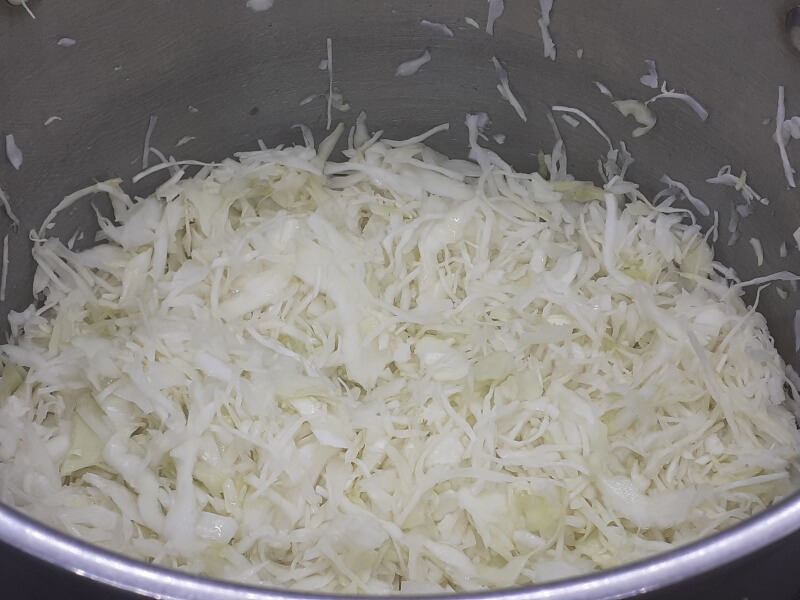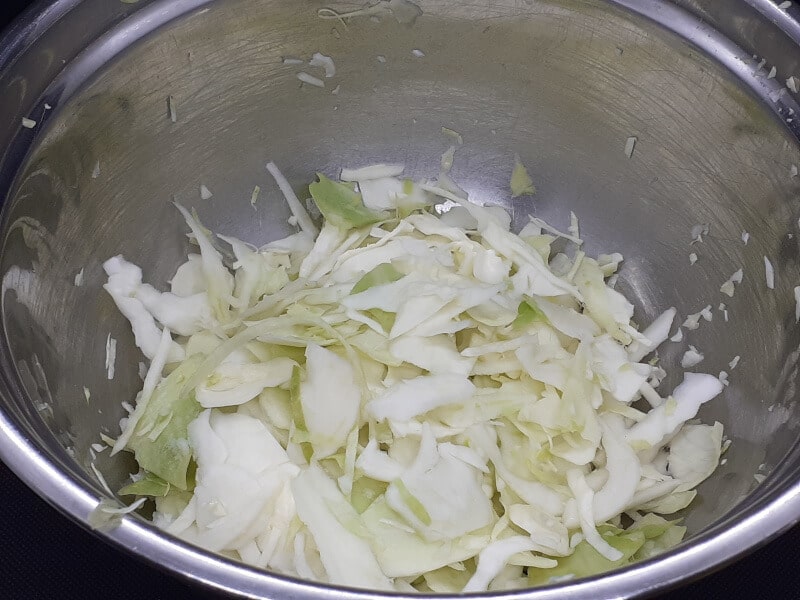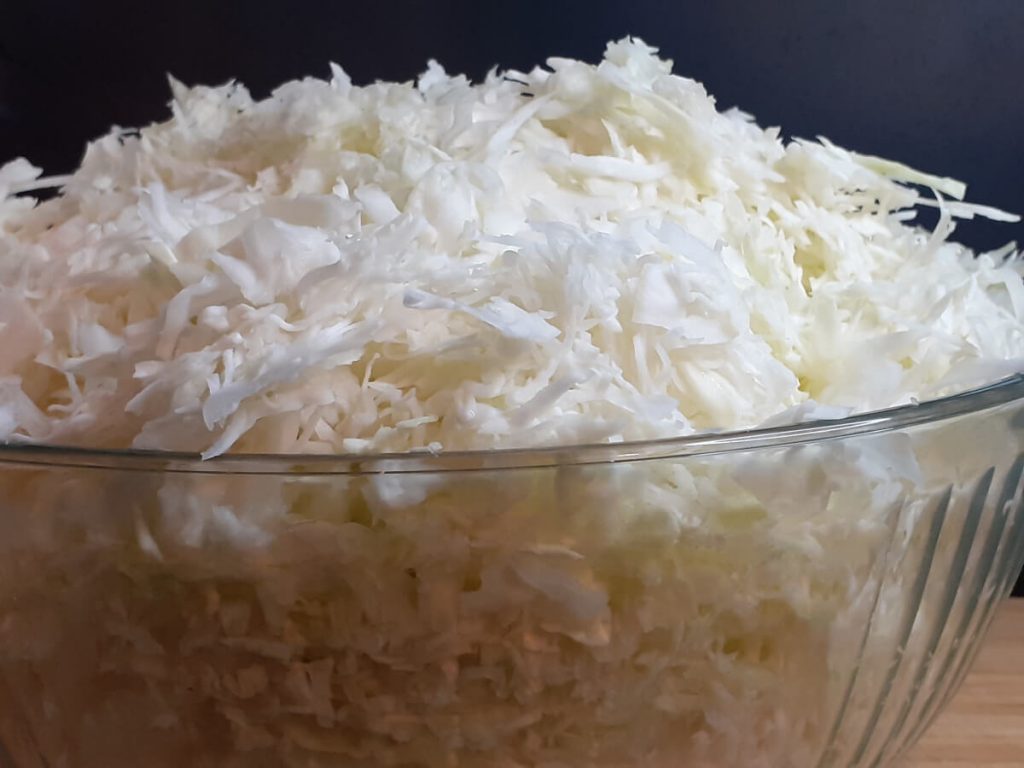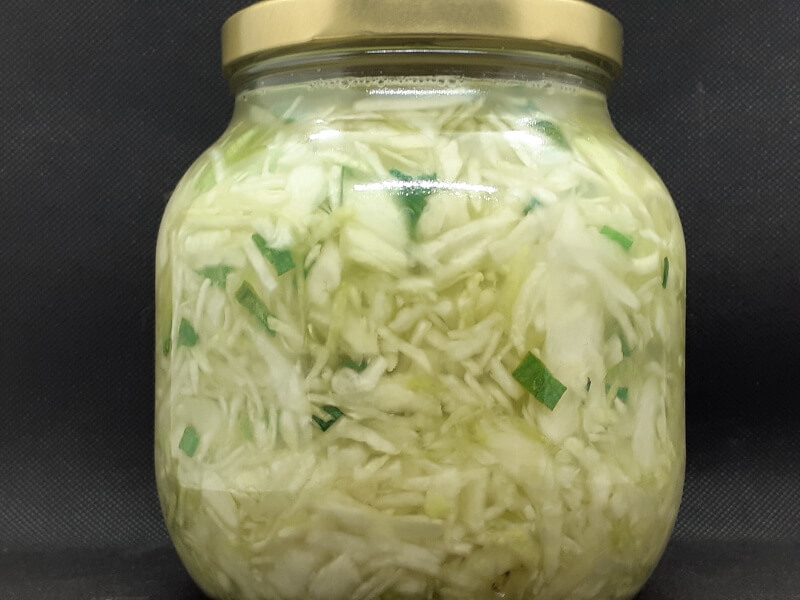Homemade Sauerkraut with a 2 % Salt solution. Loaded with natural probiotics with huge health benefits. Add in Herbs & Spices to shape the flavors to your liking.
It’s super easy to make at home. If you’re worried about messing something up, don’t. Homemade Sauerkraut is extremely forgiving and pretty hard to mess up.
The word Sauerkraut actually means Sour Cabbage in German. Sauerkraut is made by a process called Lacto fermentation by which lactic-acid bacteria convert sugars in cabbage into lactic acid. The lactic acid gives sauerkraut its “tang” and naturally preserves it.
Why make Sauerkraut?
The heat processing of canned sauerkraut destroys live probiotics and viable digestive enzymes. Losing the health benefits. Homemade Sauerkraut preserves the probiotics, allowing you to reap the health benefits.
Some of the stated benefits are as follows:
- Natural Probiotic – better than store bought. Offering a wider range. Sauerkraut contains live and active probiotics that act like your first line of defense against various harmful bacteria or toxins that might enter your body.
- Improves Digestion. Sauerkraut is high in digestive enzymes that help to break down starches, proteins, and fats.
- Boost your Immune System which is in direct relation to improved Digestion.
- May Help loose weight. Low in calories and high in fiber.
- Vitamin K2 source. Sauerkraut contains Vitamin K2, one of the most important nutrients for long-term bone health due to its ability to assist calcium and other minerals to bind into the bone matrix to strengthen bones.
- Reduce overall Inflammation
- Protects against H Pylori infection
- Promotes Heart Health
- Sauerkraut has high levels of Vitamin C. For collagen production and as a natural antioxidant for immune system support. It increases as it ages.
- And so much more…
Preparing Sauerkraut
The basic method is that you remove the outer leaves. Chop it into quarters. Remove the core and thinly slice. You can slice it thin by Hand, Mandolin, or use a Food processor. Once you have it sliced to your preferred width, it is ready for salting. Place the Cabbage in a pot and leave it be for awhile.

How to Slice Cabbage for Sauerkraut
No matter your slicing method, you want the cabbage sliced thin. Slicing by Hand is the most time consuming. Even better is a Mandoline to slice the Cabbage and will produce consistent size Cabbage and fairly quickly. Although I always opt for the food processor, because it so quick.
A food processor will take just a minute or so to run through and is the fastest method of slicing Cabbage. Although you do get inconsistent results. There will be large pieces that didn’t go through the food processor correctly and these will have to be removed and then the Cabbage weighed to calculate the Salt.

Large Pieces of Cabbage
When running the Cabbage through a food processor, you will have to sift through the Cabbage and remove large pieces that didn’t shred right.
Sauerkraut Salt Percentage
Weigh out the cabbage to find its total weight. Calculate 2 % of that for Kosher Salt.
Example: The cabbage I got gave me 1860 g of sliced cabbage. Which equals = 37.2 g of Kosher Salt (2%).
Weight of Cabbage * .02 for 2 % = the amount in grams of how much salt to add.
Sprinkle the Salt over the Cabbage, squeeze and toss the cabbage. Let it sit for 30 minutes or more. The Salt will act as an abrasive and draw moisture out. You just have to give it some time to do so.

Sauerkraut Brine Solution
The Brine Solution is made up in another bowl and used to fill the jar up once the Cabbage has been placed into the Jars. Use the Natural juices released from Salting the Cabbage and the Brine solution to top it off.

Sauerkraut Brine
Combine separately into another bowl the below and use as needed to fill the jar and bring the liquids close to the top about 1/2 – 1 inch from the top.
- 4 Cups of Distilled Water
- 1 Tbl Sea Salt
How to Sterilize Jars
You can use any Jar. Use Mason Jars, Dill Pickle Jars, or other Jars that previously held fermented foods. Be sure to sterilize the jar and lid.
Place a rack in the pot so that the jars do not touch the bottom. Place the jars and lids into the pot and fill with water. Boil the jars and lid for 15 minutes, completely submerged in water. Then set aside until ready to use.
It’s very important to make sure that everything you use that will come into contact with the food is sterilized. This will prevent any possible unwanted bacteria growth.
Boil for 10 minutes if you live in an area of 0-1,000 feet elevation. At higher altitudes, you’ll need to add 1 additional minute per 1,000 feet of elevation.
Visit https://whatismyelevation.com/ to find out what your elevation is.
Filling the Jars
Fill the jar/s up with the sliced cabbage. Pour in any juices extracted and top off with brine if needed.
Make sure all the cabbage is under the brine and that the brine reaches up to 1/2 inch to 1 inch from the top. Move the cabbage around to release trapped air bubbles and compact it.
Place this in the cupboards with the lid on tight to create an anaerobic environment for 5-6 days on a catch pan in case there is any seepage of liquids from fermenting that will spill over. Be sure to open the lid to release any air every day. If you do not do this. It can leak from the jars or even worse explode from too much pressure.

Fresh Homemade Sauerkraut
- Pack the Cabbage into the Jar along with any juices extracted when salting the cabbage
- Fill with the Brine Solution
- Use a Fork to move the cabbage around and release any air bubbles that may be trapped
- Pack the Cabbage down tight and fill up to 1/2 inch to 1 inch from the top with the Brine solution.
- Cover with a lid, place on a plate and into the cupboards for 5 – 6 days.
How long to ferment Sauerkraut
After 5-6 days, taste it and ferment longer if desired for 2-3 weeks. After which you can place it in the fridge and you will not have to release the air every day. The fridge will slow down the fermentation a considerable amount. So once you have it tasting the way you want. Refrigerate it.
The longer it ferments the sourer it will get. The more sour the sauerkraut is, the more health benefits there are.
Occasionally you will see some bacteria growth on the surface. This is okay and can be scooped off. Make sure that your Sauerkraut is completely submerged and tighten the lid again. The Sauerkraut is still safe because of the lactic acid. If however something does go off or is abnormal, use your Judgement and discard the batch. As always with fermented foods, if in doubt throw it out.
Recipes with Sauerkraut

Sausage Sauerkraut and Beans
Cook up some canned Beans stovetop and some Sausages in the Air Fryer or Oven. Plate them both with some Sauerkraut.
This combination is so wholesome. Because of the health benefits of homemade sauerkraut, this is a dish that should be a regular on everyone’s menu.

Beans and Hotdogs with Sauerkraut
Slice some hot dogs and pan fry. Then add a can of Beans and heat through. Plate with some Sauerkraut on the side.

All Dressed Steamie
Steamed Hot Dog & Buns with Dijon Mustard, Sauteed Onions and Sauerkraut.
Some other uses for Sauerkraut:
- Add to Coleslaw
- Burgers
- Sandwiches (Reuben, Tuna, Corned Beef, more)
- Chopped up into soups or stews that need some acid.
- Cabbage Rolls
- Salads
- As a side and more… just get creative.
What to add to Sauerkraut
Any combination of Herbs & Spices can be used along with White Wines, small amounts of Vinegar, Pickling spices, and even other vegetables like Onions, Radish, Carrots, etc…

Made with
- 5 Lindi peppers
- 1 tsp of Aleppo & Sumac

Sauerkraut with Green Onions
1-2 Green Onions Chopped and added with the Cabbage.

Soured Sauerkraut
- 1400g Shredded Cabbage
- 28g Sea Salt, to salt the cabbage
- Brine
- 3 C Distilled Water
- 1 C White Vinegar
- 1 Tbl Sea Salt
Equipment
- 2 Mason Jars or 1 large Pickling Jar
- 1 Large Pot
- 1 Digital Scale
- 1 Food Processor fitted with shred blade or slice by hand
Ingredients
- 1000 g Cabbage
- 20 g Kosher Salt or Sea Salt - 2 % of the total Cabbage Weight
Sauerkraut Brine Solution
- 4 C Distilled Water
- 1 Tbl Sea Salt
Instructions
- Boil 1 large Pickle Jar or 1 – 2 Large Mason Jars with lids for 15 minutes. Set aside until ready to use.
- Remove outer leaves of Cabbage and chop the Cabbage into quarters. Remove Core and thinly slice or run through the processor fitted with the shredding blade. Weigh the Cabbage in order to determine 2 % in Salt. (Total weight of Sliced Cabbage * .02 = Salt in grams needed)Place the Cabbage into a pot and sprinkle over the weighed out Salt. Squeeze and work in the Salt & Cabbage. Then let sit for 30 minutes or longer.
- Meanwhile make the brine solution. Mix until all the Salt is dissolved into the Water.
- Place Cabbage into the large Pickle Jar with any juices. And top up with the brine solution. Ensure that the liquid comes up to about 1/2 inch to 1 inch from the rim.Move the Cabbage around to release any trapped air bubbles and ensure that all Cabbage is submerged in the brine. Place the lid on and store in your cupboards with a plate or bowl underneath just in case there is any leakage from built up pressure.
- Every day release the trapped air and seal again. Taste test on the 5th day. Ferment longer if desired, 2- 6 weeks.Once the Sauerkraut taste is to your liking, refrigerate. You won't have to open the lid every day as the fermentation will slow down considerably.

